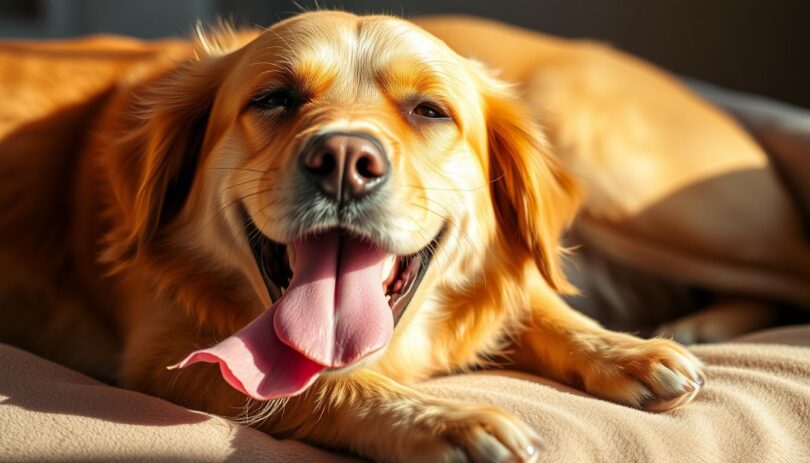What does it mean when your best friend can’t catch their breath? Panting helps dogs regulate body temperature since they don’t sweat like humans. While this behavior is normal after playtime or walks, heavy breathing during rest could signal something deeper.
Healthy adult dogs typically take 15–35 breaths per minute when relaxed. Owners should monitor their pet’s baseline patterns. A sudden increase in resting panting might point to overheating, stress, or health concerns.
Evaporation through the tongue and gums cools their body. But if your companion pants excessively without recent activity, it’s time to investigate. This article explores harmless habits versus red flags requiring veterinary care.
You’ll learn how to distinguish anxiety-driven panting from symptoms linked to heart or lung issues. Later sections break down actionable steps and when to schedule an appointment. Knowledge empowers you to protect your pup’s wellbeing.
Always provide fresh water and a cool environment. When in doubt, consult a trusted vet—they’ll help decode your dog’s unique language.
Recognizing Normal Versus Abnormal Panting in Dogs
Assessing your pet’s panting begins with establishing their normal respiratory rate. Familiarity with baseline patterns helps spot deviations early. A relaxed adult companion typically takes 15–35 breaths per minute—count chest movements for 30 seconds and multiply by two for accuracy.
Healthy Breathing Patterns and Baseline Rates
Consistency matters. Track breathing when your furry friend naps or lounges calmly. Rates exceeding 40 breaths per minute at rest warrant attention. Note environmental factors like room temperature, as heat often amplifies temporary panting.
Identifying Signs of Excessive or Rapid Panting
Watch for labored breathing, trembling, or unusual postures. Abnormal patterns include continuous panting without recent activity or sudden intensity changes. Pale gums, excessive drooling, or reluctance to lie down often accompany health-related respiratory issues.
Compare current behavior to historical norms. Occasional heavy breathing after playtime is expected, but persistent symptoms lasting over an hour signal potential trouble. Document episodes—details like duration and triggers help veterinarians diagnose underlying conditions efficiently.
Examining the Causes: Heat, Heart, and Beyond
Understanding abnormal breathing in resting pets involves exploring three key areas. Environmental stressors, internal health challenges, and genetic traits all play distinct roles. Recognizing these factors helps owners respond appropriately to their companion’s needs.
Environmental Factors and Overheating
High temperatures strain a pet’s cooling system. Dogs release heat primarily through paw pads and panting—evaporation from the tongue and respiratory tract lowers body temperature. During heatwaves or intense play, this process works overtime. Always provide shade and water to prevent overheating risks.
Medical Conditions Affecting Breathing
Persistent panting often signals underlying issues. Heart disease reduces oxygen circulation, forcing heavier breathing. Lung disorders like pneumonia create fluid buildup, while pain from arthritis or injuries triggers stress responses. These conditions require veterinary diagnosis for proper management.
Breed-Specific Considerations in Panting
Short-nosed breeds face anatomical challenges. Pugs, bulldogs, and boxers often experience brachycephalic syndrome—narrowed airways that hinder airflow. Their panting may sound louder or more labored compared to long-snouted dogs. Owners of these breeds should monitor breathing patterns closely during warm weather.
Insights on why is my dog panting while resting: Medical Explanations
Decoding your companion’s respiratory signals requires understanding key medical red flags. While occasional panting is normal, certain patterns demand immediate attention from veterinary professionals.
Critical Symptoms You Should Never Ignore
Heavy panting becomes medically significant when paired with specific signs. Watch for blue-tinged gums (cyanosis), raspy noises during breathing, or sudden collapses. These often indicate oxygen deprivation or cardiovascular distress.
Stress and anxiety can intensify existing issues. A frightened pet experiencing labored breathing might need urgent care if their tongue appears darker than usual. Document timing—panting that starts abruptly after eating could suggest poisoning.
Emergencies Requiring Same-Day Vet Visits
Act fast if heavy breathing accompanies vomiting, diarrhea, or disorientation. These often signal heatstroke or toxic exposure. One owner noticed their terrier panting excessively with dilated pupils—turned out the dog had ingested chocolate.
Trust your instincts. If resting respiratory rates exceed 40 breaths per minute for over 30 minutes, contact your vet immediately. Persistent panting with pale gums could mean internal bleeding or anemia.
Most pets recover fully when owners recognize these warning signs early. While not every pant spells danger, rapid response to critical symptoms saves lives. Keep your vet’s emergency number handy, and remember—timely action bridges worry to relief.
Taking Action: Monitoring Your Pet and Seeking Veterinary Care
When your companion shows unusual breathing patterns, quick response matters. Start by moving them to a shaded area with good airflow. Offer fresh water immediately—dehydration worsens respiratory distress. Apply cool (not cold) towels to paw pads and underbelly to lower body temperature gradually.
Track breathing rates every 15 minutes using a stopwatch. Note any changes in gum color or energy levels. Keep a log detailing when symptoms began and potential triggers like recent meals or environmental changes. This documentation helps vets pinpoint issues faster.
Contact your veterinarian if rapid breathing persists beyond 30 minutes or accompanies lethargy. For after-hours emergencies, locate the nearest 24-hour animal hospital. Many clinics offer telehealth consultations for initial assessments—use these services when transportation isn’t immediate.
Early intervention prevents minor issues from becoming critical. Create a calming environment using white noise machines or familiar blankets if anxiety appears involved. Schedule follow-up appointments even if symptoms improve—some conditions require professional monitoring.
Trust your instincts. You know your pet’s normal behavior best. Persistent panting during rest often signals needing expert evaluation. Keep emergency contacts visible and act decisively—your vigilance directly supports their health and comfort.
FAQ
What causes heavy panting in dogs during relaxation?
Common triggers include overheating, pain, stress, heart conditions, or respiratory issues. Breed traits (like short snouts in Bulldogs) or medications may also play a role. Observe for additional symptoms like pale gums or lethargy.
How can I tell if my dog’s breathing requires veterinary attention?
Seek immediate care if panting accompanies blue/pale gums, collapsing, labored chest movements, or unresponsiveness. Rapid breathing at rest without obvious heat/exertion causes also warrants a vet visit.
Do certain dog breeds naturally pant more frequently?
Brachycephalic breeds (Pugs, French Bulldogs) often struggle with breathing due to narrowed airways. Northern breeds like Huskies may pant more in warm climates. Always compare to your pet’s baseline patterns.










Leave a Comment